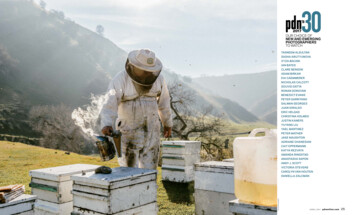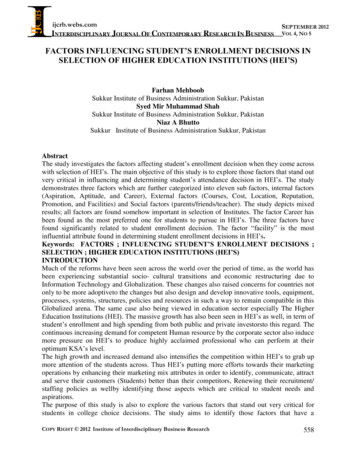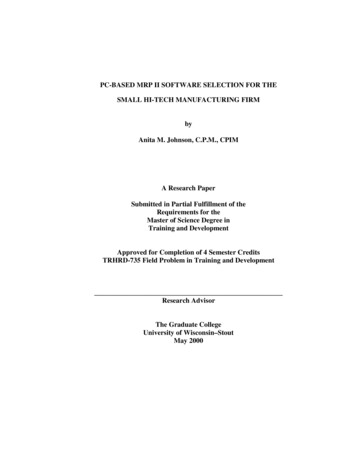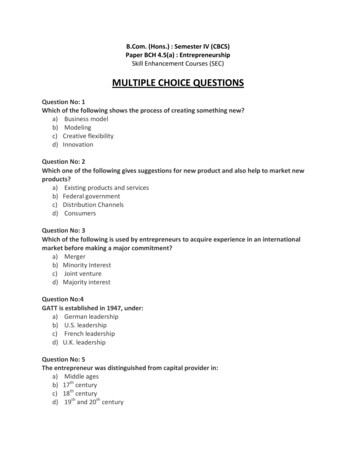
Transcription
Our Choice ofNew And EmergingPhotographersTo WatchTasneem AlsultanSasha ArutyunovaXyza BacaniIan BatesClare BensonAdam BirkanKai CaemmererNicholas CalcottSouvid DattaRonan DonovanBenedict EvansPeter GarritanoSalwan GeorgesJuan GiraldoEric HelgasChristina HolmesJustin KanepsYuyang LiuYael MartinezPeter MatherJake NaughtonAdriane OhanesianCait OppermannKatya RezvayaAmanda RingstadAnastasiia SaponAndy J. ScottVictoria StevensCarolyn Van Houten Justin KanepsDaniella ZalcmanApr il 2 01 7pd no nl i ne . c o m25
Katya RezvayaOur Choice ofNew And EmergingPhotographersTo WatchEditor’s NoteReading about the burgeoning careers of these 30photographers, a few themes emerge: Personal, selfassigned work remains vital for photographers; workshops,fellowships, competitions and other opportunities to engagewith peers and mentors in the photo community are oftenpivotal in building knowledge and confidence; and demeanorand creative problem solving ability keep clients calling back.Many of the 2017 PDN’s 30 gained recognition bypursuing projects that reflect their own experiences andinterests. Salwan Georges explored the Iraqi immigrantcommunity of which he’s a part. Xyza Bacani, a onetime domestic worker in Hong Kong, is using her uniquebackground to tell stories of “invisible people” who areliving as she once was. Tasneem Alsultan is working tochange the way people see Saudi and Arab women. AndClare Benson’s family and upbringing have been importanttouchstones in her fine-art work.Several photographers cited workshops, fellowships,mentorships and other opportunities that propelled them.26p d n o n l i n e. c o m A p r i l 2 0 1 7Interning helped Carolyn Van Houten learn about workingas a photographer; the Missouri Photo Workshop helpedRonan Donovan expand his storytelling skills; SouvidDatta gained recognition through the IdeasTap/MagnumInternational Photography Award, and Daniella Zalcman’sgrants from the Pulitzer Center on Crisis Reporting alteredthe course of her career.In their assignment work, these photographers deliverfor their clients without fuss. Benedict Evans, a clientsays, “set himself apart” because people like to work withhim. Ian Bates is known as a hard worker who will figurea story out. And Amanda Ringstad has, a client says,strong views but “very little ego.”The path to a successful photography career can seemmysterious at times, and there is certainly no one-sizefits-all formula. But as the stories of these photographerssuggest, pursuing one’s personal vision, buildingcommunity and working hard for clients has helped manyphotographers find their way. —Conor Risch
PDN thanks the followingpeople for nominatingphotographers for the2016 PDN’s 30:David AlexanderArnold,Travel LeisureAlexandra Garcia,International Leagueof ConservationPhotographersAllie Fisher,WIREDAllyson Torrisi,Popular MechanicsAmy Feitelberg,SquareMaggie Steber,photographerMarianne Campbell,Marianne CampbellAssociatesMarvin Heiferman,Michael Kamber,Ariel Shanberg,Michael Mack,Ariel Zambelich,Michelle Bablitz,DaylightphotographerMACK booksAsh Barhamand,SAINT LUCYRepresentsAshley Lumb,This RepresentsBrian Sholis,Pulitzer Center onCrisis ReportingCatherine Edelman,TBW BooksWWDThe Bodleian Libraries,University of OxfordcuratorNatalie Flemming,Nathalie Applewhite,Paul Schiek,CatherineEdelman GalleryPeter DiCampo,Charles Traub,Romke Hoogwaerts,Darren Ching,Samantha Johnston,School of Visual ArtsKlompching GalleryphotographerMosslessDeb Wenof,Colorado PhotographicArts CenterElizabeth Krist,SFMOMAEmily Keegan,MetrographyRefinery29photo editorThe FADEREmily Nathan,Tiny Atlas Quarterly Victoria StevensThe New YorkTimes MagazineAnn Jastrab,NPREsa Epstien,sepiaEYEFred Bidwell,Transformer StationIhiro Hayami,Tokyo Institute ofPhotographyJacqueline Bates,The CaliforniaSunday MagazineJames Estrin,The New York TimesJeff Jacobson,p d n o n l i n e. c o m A p r i l 2 0 1 7Kathy Ryan,Michael Itkoff,curator28Photo:Andrew Nedimyer,Rayko Photo CenterOur Choice ofNew And EmergingPhotographersTo WatchJohn Fleetwood,writer, curator,ICP/Bard, SVA facultyHum CreativePDN thanks the Sponsors of PDN’s 30for their support of this issue and ofthe PDN’s 30 educational programs.ICP MuseumCoEdit CollectionAmy Wolff,to See more images by the 2017 PDN’s 30 Photographers, Visit PDNs30.comJoanna Lehan,photographerJigisha Bouverat,Jigisha BouveratCollectiveSandra S. Phillips,Sebastian Meyer,StaceyClarkson James,Harper’s MagazineStephen Perloff,The Photo ReviewSteven B. Smith,Rhode IslandSchool of DesignTara Guertin,AFARTom Claxton,Webber RepresentsW.M. Hunt,curatorYaelle Amir,NewspaceCenter forPhotographyZara Katz,producer
AGE: 30BORN: NuevaVizcaya, PhilippinesRESIDES: “Livingout of a suitcase fortwo years now.”WEBSITE:xyzacruzbacani.com30p d n o n l i n e. c o m A p r i l 2 0 1 7All Photos Xyza BacaniCLIENTS:The New York Times Lens blog, ChinaFile,South China Morning Post, FujifilmEXHIBITIONS: Arrow Factory, Beijing;Manchester Craftsmen’s Guild Youthand Arts Gallery, Pittsburgh, PA;Kong Art Space, Hong KongAWARDS: Pulitzer Center on Crisis ReportingTravel Grant; Forbes 30 Under 30 Asia;Magnum Foundation Human RightsFellowship; BBC 100 Women of 2015;Visionaries 2015; Justice Centre Hong KongHuman Rights Arts PrizeBIGGEST CHALLENGE: “Starting out as afreelancer, I do not have a safety net, so failingis not an option. My family is poor. For me it’simportant that we survive first. When I got theMagnum Foundation Fellowship, I was reallyhappy, then reality sinks in: If I go to New Yorkand lose my job, will I be able to support myfamily? My family and my [former] employersaid, ‘Opportunity only comes once. It’s achance to change your life, so why not?’ It wasscary, so I tripled the hard work.”Justin KanepsAge: 27Born: Somerset, NJResides: San FranciscoEducation: The Art Institute of BostonWebsite: justinkaneps.comClients: Bloomberg Businessweek, The California SundayMagazine, The New York Times, Surface, Fast Company, SanFrancisco Magazine, AirbnbExhibitions: Leila Heller Gallery, New York; Book & Job Gallery,San Francisco; Centro Fotográfico Manuel Álavarez Bravo, Oaxaca, MexicoAwards: Magenta Foundation Flash Forward; American Photography 32Best advice: “It’s important to have a community of photographers for support, but I thinksometimes photographers get stuck inside of that and become insular within the photographycommunity. Make an effort to expand your community beyond photographers to other typesof artists.”All Photos Justin KanepsXyzaBacaniXyza Bacani had been adomestic worker in Hong Kong fornearly ten years when photographerRick Rocamora discovered herstreet photography on Facebook.Her photographs stood out for theircomposition, layering, dramatic lightand decisive moments. Rocamorabrought her to the attention of The NewYork Times, which debuted her work onLens blog in 2014. Almost overnight,Bacani’s life changed.“Because of my sexy backgroundstory, I got a lot of media exposure,”she says. Journalists who did storiesabout her began sending assignmentsher way. In 2015, she came to NewYork on a Magnum Foundation HumanRights Fellowship. With mentoringfrom Susan Meiselas, Bob Sacha andothers, she learned storytelling andmultimedia skills. Bacani now supportsherself primarily through print salesand editorial assignments that make itpossible for her to pursue her ongoingproject about immigrant labor aroundthe world.“She organizes often complexphotographs really well,” says JamesEstrin, co-founder of The New YorkTimes Lens blog. “Why I’m so impressedis that she moved into doing thisincredibly important work on domesticworkers she has the access, andability to see it like nobody else can.”Bacani first tried her hand at painting,then bought a camera. “I was like, ooh magic!” she recalls. She carried iteverywhere. “At night I snuck out from myemployer’s home to take pictures.”She went online to study the workof Henri Cartier-Bresson, Fan Ho andPedro Luis Raota. She also studied howRenaissance painters “play with thelight and composition.” And she bingedon movies, pausing on scenes thatcaught her eye. “The first thing I learnedis that light is everything. Even if yourform and content are beautiful, if yourlight is flat, it’s not going to be visuallyappealing,” Bacani says.Lately she has been studyingthe elements of design, to betterunderstand composition and hone hervisual instincts. “My photography is allabout instinct and feeling and mood,”she says. Her aspiration is to continueworking, “doing shows and tellingstories, especially underreported onesabout invisible people,” she says. —David Walker“Even if my assignment is one portrait,I’ll go above and beyond and try to put together astory,” says Justin Kaneps. His work ethic and hisability to combine portraits with storytelling havecaught the eye of photo editors. “His pictures aresuffused with natural light and rich colors andtextures that give them a vivid, dreamy quality,”says Bloomberg Businessweek’s Clinton Cargill,who assigned Kaneps to shoot a cover story onLevi’s. “They also fit clearly in the tradition of theearly color photographers It gives his picturesa sense of nostalgia that worked perfectly toportray an iconic American brand like Levi’s.”Kaneps breaks down his approach tophotography like this: minimal gear, respectfor subjects, let the work speak for itself.He balances the meticulously placed and thearbitrarily happened-upon, the thoughtfuland the spontaneous. At art school, he washeavily influenced by the New Topographicsphotographers, but when he started makingportraits in 2011, he looked to the work ofWalker Evans and Lewis Hine. Moving forward,he hopes eventually to dig into long-termstorytelling projects in places as far flung asAlaska, Guatemala, Latvia or Sweden.Kaneps credits human connection andcommunication with both peers and editors forthe advancement of his career thus far. “I wear myheart on my sleeve, but it’s helped me forge deepconnections to my peers, mentors and subjects,”reveals Kaneps. Meeting individually with editorsin their offices has been more helpful for earningassignments than attending portfolio reviews orfestivals. Speaking about marketing his work, hesays there’s a lesson he’s learned: “Keep a fire inyour heart and if you really want it you’ll get therewith a fine balance of patience and persistence.” —Sarah StackeApr il 2 01 7pd no nl i ne . c o m31
Victoria StevensAGE: 32BORN: Dunedin, FLRESIDES: New York CityEDUCATION: Savannah College of Art and DesignWEBSITE: victoriastevens.netAll Photos Adam BirkanCLIENTS: WWD, W Magazine, Interview Magazine,Dior, Capitol Records, Interscope RecordsAWARDS: 2015 PDN FacesBest Advice: “Pitch your own assignments. It’s better thanwaiting around. When I first started I thought, ‘Okay, I have a degree. Editors are going tofind me and pitch this to me,’ and that didn’t happen right away. Pitch your own ideas.”After art school, Victoria Stevens moved toNew York City in 2007, and explored the commercialphotography world by assisting photographerswho were shooting still life, fashion and portraitson large-scale studio shoots. She also did jobs inproduction and retouching.Then she became a full-time photo editor atCity magazine, and it exposed her to a differentesthetic. The first time she shot for the magazine,she photographed the band The XX. Instead ofusing strobes, sets or any of the props she had beenaccustomed to using as an assistant, she usednatural light. “That was it,” she explains. “That mademe say, ‘I’m a photographer.’” The pared-down approacheventually became the foundation of her artistic vision.Stevens began taking photographs morefrequently, giving herself assignments to shootmusicians, actors and directors. Breaking out of thestudio enabled her to “get the shot quicker, and getwhat I want without relying on strobes all the time,”she says, an approach ideal for capturing celebritiesor directors with limited time.After City folded in 2012, Stevens joined AnthemMagazine as photo editor/photographer-at-large.She gave herself assignments to travel to musicand film festivals, honing her style and building upa portfolio she could show to clients. She pushesherself, even when her time with a celebrity is short.“Never settle for a shot,” she says.As a former photo editor who now pitches photoeditors, Stevens recognizes the importance ofconstantly promoting yourself. “Treat every situation likea networking opportunity,” she advises. “You never knowwho you’re going to meet.” —Stacey GoldbergAdam BirkanAGE: 26BORN: JerusalemRESIDES: BangkokEDUCATION: Ohio UniversityAll Photos Victoria StevensWEBSITE: adambirkanphoto.com32p d n o n l i n e. c o m A p r i l 2 0 1 7CLIENTS: GQ, Vogue, The New Yorker, The New York Times,Bloomberg Businessweek, Free Men’s WorldEXHIBITIONS: JAM Gallery, Bangkok; Bangkok Art & Culture Center;Miami Street Photography FestivalAWARDS: Magnum 30 Under 30, National Geographic Photo Contest,PDN Emerging Photographer, PDN World in Focus.BIGGEST CHALLENGE: “My goal is to have photos that appeal to my mom,to my mentors, to industry professionals, to artists and to guys on the street.I’ve only ever taken two or maybe three that accomplish that. I want more.”As an undergrad, Adam Birkan studiedphotojournalism at Ohio University’s School of VisualCommunication, a program designed to train “staffnewspaper photographers,” says Birkan. For fun, heand his friends would watch documentaries aboutphotographers. One, about William Eggleston, wasa revelation to Birkan. “After four years of hardcorephotojournalism, watching William Eggleston just blewmy mind,” he says. “The next day I was taking picturesof cracks in the street.” While his studies had focusedon telling stories, Eggleston was appealing in that“he doesn’t have grand ideas,” says Birkan.His interest shifted from photojournalism tophotography as art, and after he graduated, Birkanmoved to Bangkok in search of an interesting placeto make pictures. With teaching English as a fall-backplan, he began working on a personal project thateventually became “All That Glitters,” a mix of street lifeand architecture that comments on economic disparity.Once he had a set of images he liked, he began submittingthem to “blogs that are good at getting your name outthere into the wild.” His work received some press andawards, and editorial assignments began trickling infrom photo editors who had come across his work.(He also emailed dozens of editors directly but says,“I never ever got a single assignment that way.”) Mostof his bigger assignments have come in the past twoyears, he says.The low cost of living in Thailand allows Birkanto choose assignments that offer the most creativefreedom, and to continue his explorations of placesthat spark his interest, from studies of life on a Thaiisland during the off-season to a look at the piecemealmodernization of the capital of Vietnam. He’s planninga trip to Israel to look for traces of recent and ancienthistory in the landscape. Rather than plan an itinerary orshot list for the trip, “I like to think I’ll find interestingthings,” he says. “But that’s what Eggleston taughtme—everything is interesting.” —Rebecca RobertsonApr il 2 01 7pd no nl i ne . c o m33
SashaArutyunovaAge: 28Born: MoscowResides: New York City34p d n o n l i n e. c o m A p r i l 2 0 1 7Immigration, opportunity, belonging:in America, these are hot-button issues. For SashaArutyunova, they are also deeply personal. Arutyunovawas six years old when she left her native Russia for theUnited States, joining her mother, who had separatedfrom her father a year earlier. Since then, Arutyunovahas shuttled between the two countries, keeping afoot in both. “Having such a close connection to twocultures allows me to step back and look at them, bothfrom the inside and the outside,” she says.In an ongoing, as-yet-untitled personal project,Arutyunova is examining everyday life in Russia throughthe lens of her family and their surroundings. The workfills what she sees as a gap in coverage of her homeland:“People who aren’t from Russia go in and take pictures,and it’s usually an overview of the country. I’m excited tobe able to tell a story that’s personal but also speaks tothis larger moment, with issues of travel and immigration.”At the same time, Arutyunova is shooting portraitassignments for magazines. After college, she producedwork for her first portfolio by shooting performancesby actor and musician friends. She became part of twoartist collectives, Mason Jar Music and Nomadique, andcontinues to shoot stills and video for both. That workled to an assignment for Hemispheres and later forThe New York Times. “Sasha brings a certain lightand sensitivity to her work,” says Alana Celii, photoeditor of The New York Times Arts & Leisure section.“She’s extremely dedicated and cares immenselyabout the work she’s doing.”In the future, Arutyunova says, she’d like to continuedoing both fine-art and editorial photography: Sheenvisages putting out a book about her family project.As for the new state of affairs between Russia andAmerica, she says, “I’m curious and horrified about howeverything is going to unfold.” With luck, she’ll be thereto capture her perspective on it. —Sarah ColemanSalwan GeorgesAGE: 26BORN: BaghdadRESIDES: DetroitEDUCATION: Oakland Community College, Royal Oak,Michigan; Oakland University, Rochester, MichiganWEBSITE: salwangeorges.comCLIENTS: Detroit Free Press, Washington Post, The New York TimesEXHIBITIONS: Arab American National Museum, Dearborn, Michigan;A. Alfred Taubman Center for Design Education, Detroit; Detroit ArtistsMarket; The Scarab Club, Detroit; Hatch Art Gallery, Hamtramck, MichiganAWARDS: Associated Press, Michigan, Best Feature Photo 2016BEST ADVICE: “I once shared with John Stanmeyer that his work inspires me,and he replied: ‘Inspiration has to come from within. From messages told to us inthe wind. Expression from a tree. Felt in our hearts. Eyes. Simply through being.The mistakes will never end, [and] therein rests your potential.’”All Photos Salwan GeorgesAll Photos Sasha Arutyunova Ike EdeaniEducation: New York University,Tisch School of the ArtsWebsite: sashaarutyunova.comClients: The New York Times,Hemispheres, AFAR, Norwegian Air, Make Room USAExhibitions: Center for Faith and Work, New York City;Brooklyn Navy Yard; Metropolitan Building, Queens, NYAwards: Passion Passport: Artist Residency with Amtrak;Center for Faith and Work Artist-in-Residence; New YorkUniversity President’s Service Award; New York UniversityThomas Drysdale Production FundKey Lesson: “The most important thing I’ve learned is that Ineed my peers. Being a photographer is a solitary experience,and it’s important to invest time in your peers and the photocommunity so that you can help each other out when needed.Fostering positivity in the photo community is so important.”Salwan Georges’s family fled Iraq in the ’90s for Syria,then emigrated to the U.S. in 2004, when he was 12 years old.“I went through the hardship of being a refugee twice, andI wanted to express my experience and feelings but I didn’tknow how,” he says. He eventually ended up at OaklandCommunity College, where he signed up for a class taught byRob Kangas. For his first assignment, Georges took picturesin a coffeehouse that his father frequented with other Iraqirefugees, playing cards and talking about their lives.Kangas was impressed, Georges says. “He said, ‘I haven’tseen this community in America. We can’t just walk in, butyou have access.’ And I thought, ‘This is really cool.’” He beganimagining a career as a photojournalist. While he was pursuinga journalism degree, Muslim extremists killed one of hiscousins back in Iraq. Georges’s shock and anger inspiredhim to start photographing the growing Muslim communityin Dearborn.“I wanted to show what it takes to come here” as a refugee,Georges says. “As I photograph refugees, in every photo,I see myself and my family’s story.”He graduated in May 2015, took an internship at theDetroit Free Press, and started reaching out to photographersand photo editors by email. That led to assignments from TheNew York Times and Washington Post to photograph storiesabout Detroit’s failing public schools, the water crisis in Flint,Michigan and other topics. It also led to a staff position atthe Detroit Free Press, and invitations to the Eddie AdamsWorkshop and VII Agency workshop.Last year, he was one of 15 photographers acceptedinto the three-year Visual Storytelling & DocumentaryPhotography Projects mentorship program organized byJames Estrin and Ed Kashi.“He’s technically really strong,” Kashi says of Georges.“But more than that, he has a real sensitivity to the subject.He’s a natural born storyteller and he yearns to push himself.I’m taken by his aspiration, and his drive and his talent.” —David WalkerApr il 2 01 7pd no nl i ne . c o m35
Jake NaughtonAGE: 28BORN: Farmington, CTRESIDES: Brooklyn, NYEDUCATION: University of Wisconsin,Madison; City University of New YorkWEBSITE: jakenaughton.comCLIENTS: The New York Times, NPR,Newsweek, VICE, GlobalPost, MasterCardFoundation, Storefront Gallery for Art and ArchitectureEXHIBITIONS: Division Gallery, Toronto; Photoville, Brooklyn, NY;Scotiabank Contact Photography Festival, TorontoAWARDS: Blue Earth Alliance sponsorship; New York Foundationfor the Arts Emerging Photographer Project Grant; Reporting Grant,Pulitzer Center on Crisis Reporting; Immigration Reporting Grant,Beacon ReaderBIGGEST CHALLENGE: “The hardest thing has been to unlearn thereceived ideas about what kind of photographs I can and should bemaking, what kind of stories I can and should be telling, what kind ofvoice I can and should have. I feel like my life is a continuous processof unlearning. I think on some level I have had to give myself permissionto dream bigger for myself and my photographs, and it was a hugeprocess to get there. I’m still getting there, actually, every day.”Carolyn Van HoutenAGE: 26BORN: Greenville, NCRESIDES: San AntonioEDUCATION: University of North Carolina at Chapel Hill36p d n o n l i n e. c o m A p r i l 2 0 1 7Jake Naughton came to photography as a disillusioned artstudent. Jesuit high school had instilled in him a passion for social justicethat he wasn’t sure how to reconcile with the insularity of the art world.“I liked to travel, I cared about the world and I was interested in esthetics,” hesays. A college friend suggested Naughton try photojournalism. He pursueda journalism degree and became the photo editor at the student newspaper.Naughton then moved to Washington, D.C., to intern at the PulitzerCenter on Crisis Reporting; he was soon hired as the multimedia projectscoordinator. He learned how to produce and fund photography projects, andhow to collaborate with editors at major publications. After three years atthe Pulitzer Center, Naughton wanted to produce his own work. “I decidedthe fastest way to build up my chops would be to go to graduate school.”At the City University of New York, Naughton found a mentor inJames Estrin, co-editor of The New York Times Lens blog. ThroughEstrin he landed an internship at Lens, as well daily assignments forthe paper. “Jake does not settle for easy images, no matter how visuallyarresting they may be,” Estrin says. “He makes great images, but whatsets him apart is the depth of his critical thinking and his ability tocommunicate his ideas and observations in nuanced ways.”Naughton says he’s strategic about his business, only pursuingstories that he knows he will be able to sell. He’s funded personalprojects through grants, and his collaborations with writers have helpedhim sell stories to major media. He also cofounded the cooperativeBlack Box with Chris Gregory, Natalie Keyssar and Alejandro Torres Viera.“We are all exploring how esthetic a news photograph can be, andpushing against what a publication can offer.” —Brienne WalshCLIENTS: National Geographic, The New York Times,TIME, Wall Street JournalAWARDS: Pictures of the Year International Newspaper Photographer of the Year;College Photographer of the Year; Magnum 30 Under 30; Hearst JournalismAwards National Photojournalism Championship; National Press PhotographersAssociation Best of PhotojournalismKEY LESSON: “Paid internships are crucial because they provide you with an opportunity towork in a community unknown to you for a period of time. You don’t have a lot to lose, so youcan experiment and figure out what you want and don’t want for yourself and your career.”All Photos Carolyn Van HoutenAll Photos Jake NaughtonWEBSITE: carolynvanhouten.comCarolyn Van Houten was a physics majorinterested in optics and the physics of light whenshe enrolled in a photojournalism class as a collegesophomore. It opened her eyes to a career that wouldallow her to blend her passion for science with herlove of connecting with people.She took more photo classes before spending thenext year zipping through photo internships at theChicago Tribune; the Tampa Bay Times; The Herald inJasper, Indiana; and the White House. “There’s only somuch you can learn in a classroom when the work youreally need to do is out in the field,” she says.Van Houten joined the staff of San AntonioExpress-News in January 2015, a month aftergraduating with a photojournalism degree. Shewasn’t done interning, though. After winning CollegePhotographer of the Year, Van Houten was invited tointern with National Geographic for four months, andgot a leave of absence from her staff job.Today she has what she calls a “dream situation”at the Express-News. “Occasionally I do daily stories,but basically it’s all long-term projects, so I pitch andwork on pretty much whatever I want to at the paper,”she says.Many of those stories humanize issues, like howthe downturn in oil prices is affecting a South Texascommunity. “Economics are always hard to visualize,”she says. “As long as you can find the people [whoare affected], then you can find visuals and importantthings to cover surrounding that issue.”Working at the newspaper has taught her to be abetter journalist, which in turn is making her a betterphotographer. “The best photography for me has comeafter I’ve done a lot of reporting and a lot of researchon an issue,” she says, “and when you understand thesubtleties of an issue, then your pictures can be a lotmore nuanced.” —Mindy CharskiApr il 2 01 7pd no nl i ne . c o m37
AmandaRingstadAGE: 36BORN: Edmonds, WARESIDES: SeattleEDUCATION: Universityof Hawaii at ManoaWEBSITE:Age: 32Born: Guerrero, MexicoResides: Guerrero, MexicoEducation: Seminario de FotografíaAll Photos Yael MartinezContemporánea, Centro de la Imagen, MexicoWebsite: yaelmartinez.comExhibitions: Centro Fotográfico ManuelÁlvarez, Oaxaca, MexicoAwards: FONCA’s Jóvenes Creadores Grant;Magnum Foundation Emergency Fund GrantBEST ADVICE: “Mary Ellen Mark always told me to pursue the projects that I lovethe most and feel most connected to. ‘Be true to yourself,’ she said. That’s the bestadvice I’ve received.”38p d n o n l i n e. c o m A p r i l 2 0 1 7The danger and violence in his home state of Guerrero,Mexico, has fueled Yael Martinez’s artistic growth. In 2013,after two of his brothers-in-law went missing, an agonizedMartinez did what came naturally: he picked up his camera.His family was grief-stricken and, slowly, Martinez tried tocapture moments that would convey the turmoil at home.“It was a way to understand what we were going through,”he says.Caused by drug wars and an often-complicit government,the problem of disappearances in Mexico continues toescalate. Martinez’s raw, personal images have an intenseintimacy and, at the same time, express an experiencecommon to many families in his country. “There are 70,000cases of missing people in Mexico—and those are onlythe ones that are reported,” Martinez says. His work,which straddles a line between documentary and fine-artphotography, is intended “to keep a memory alive,” he says.Previously, Martinez had captured another difficultperiod for his family: the last years of a belovedgrandmother who suffered from Alzheimers. In 2012, thatwork caught the attention of Mary Ellen Mark, who wasteaching a workshop Martinez attended in Oaxaca. Markwas impressed enough to give Martinez a scholarship to hermasterclass in New York, where a fellow student, ErnestoBazan, introduced him to James Estrin of The New YorkTimes Lens blog. A feature on Lens followed, and then Markintroduced Martinez to Joan Liftin, a veteran photo editorand photographer. “His pictures really bounced; they werefull of life and energy,” Liftin remembers. She recommendedhim for a Magnum Foundation Emergency Fund Grant,which he won in 2016.Now expanding his work on Mexico’s disappeared, Martinezhas started photographing other families of missing people.He would like to put out a book and build a website on theissue. “I will always photograph things that relate to me andmy country,” he says. “It’s the only thing I can do.” —Sarah ColemanAll Photos Amanda RingstadYaelMartinezamandaringstad.comCLIENTS: BloombergBusinessweek, SightUnseen, Fast Company, Refinery29, PopularMechanics, Amazon, Tom Dixon, Design WithinReach, Civilization, Brooks RunningEXHIBITIONS: Fosdick-Nelson Gallery, Alfred, NYKEY LESSON: “Figuring out the work-life balance.I’m a really hard worker, so I think that I used towork too hard and that would kind of burn me out.I’ve figured out a better balance in how to work andbe happy and take care of myself. I think it’s reallyeasy to fall into an unhealthy cycle of staying up allnight hunched over a computer because you’ve gotto get something done. You can tell yourself that it’sOK, that it’s good enough. You don’t have to keep going.Sometimes what I think is right, it’s unrealistic in termsof the timeframe and what other people might expect.”Although she had a degree in photography and worked in andaround the industry—as an assistant, printer and retoucher, amongother jobs—Amanda Ringstad
Bacani first tried her hand at painting, then bought a camera. “I was like, ooh magic!” she recalls. She carried it everywhere. “At night I snuck out from my employer’s home to take pictures.” She went online to study the work of Henri Cartier-Bresson, Fan Ho and Pedro Luis R











